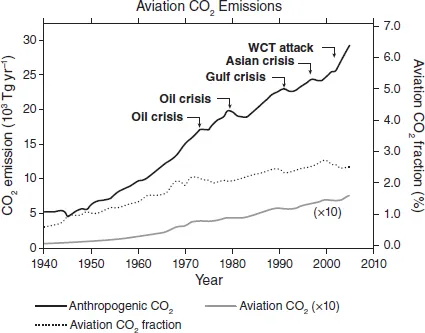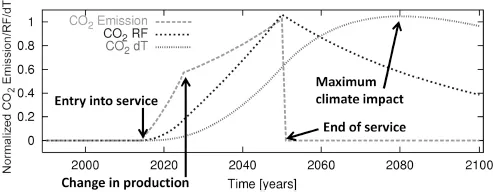1 Introduction and overview
Frank Fichert, Peter Forsyth and Hans-Martin Niemeier
Climate change is one of the crucial global problems of the 21st century. Nations have responded to this challenge by unilateral measures as well as international agreements on reducing greenhouse gas emissions. Important milestones have been the United Nations Framework Convention on Climate Change (UNFCCC) of 1992, followed by the Kyoto Protocol in 1997. More recently, in the Paris 2016 agreement, the aim of keeping the global temperature rise well below 2 degrees Celsius above pre-industrial levels was formulated, with an additional ambition to limit the temperature increase even further to 1.5 degrees Celsius. Many jurisdictions have defined pathways for reducing CO2 emissions, often aiming at a “decarbonisation” of the economy.
The economic aspects of climate change have been addressed in many publications. William Nordhaus analysed climate change already in the 1970s and received the Nobel Prize in Economic Sciences in 2018. The Stern report, published in 2007, had a major influence on the public debate on climate change policies. Nowadays, the economics of climate change are a common element in every textbook on environmental economics.
The aviation industries’ contribution to climate change became a major topic by the 1990s. In 1999 the Intergovernmental Panel on Climate Change (IPCC) issued a special report on “Aviation and the Global Atmosphere”. For several years, the International Civil Aviation Organization (ICAO) has discussed different ways to reduce international aviation’s contribution to global warming. Technical options for more fuel-efficient aircraft and the potentials of renewable fuels have been analysed thoroughly throughout the world. Many initiatives have been formed to foster research and development; for example, the European research program “Clean Sky”, which also looks into other environmental issues like noise reduction. Large airlines publish sustainability reports, explaining their initiatives to limit CO2 and other emissions. The problem is made more complex because of the fact that it is not only carbon emissions which lead to global warming – other gases, such as nitrous oxides, also contribute to the problem. Carbon emissions may be responsible for only about a third of the overall problem.
Policy makers, as well as economists in particular, have been discussing the pros and cons of different policy instruments in the air transport market. From the 1990s, non-governmental organizations (NGOs) and also some political parties have been arguing in favour of higher taxes on aviation in order to limit air transport’s growth and emissions. However, the international nature of aviation requires international cooperation in order to implement measures which are effective as well as efficient. For example, the European Union’s initial approach to include not only intra-European flights but also flights from Europe to non-EU member states in its Emissions Trading Scheme (ETS) caused conflicts with countries affected by this measure. Finally, in 2016 ICAO initiated a global market-based scheme, CORSIA (Carbon Offsetting and Reduction Scheme for International Aviation), to achieve carbon-neutral growth of international air transport, which will be implemented stepwise beginning in 2021.
Given the intense debate and the many policy initiatives sketched here, it is not surprising that there are already some books on aviation and climate change; for example, Gössling and Upham (2009). Moreover, a large number of papers have been published in journals focusing on air transport and sustainability, respectively.
The focus of this volume is narrower than that of other more general books on climate change and air transport. The focus here is on policies, and on the economic analysis of those policies which are being used, or are suggested, to lessen or eliminate the greenhouse gas emissions of air transport. There have been a range of policies which rely on economic instruments and which have been used, or are being suggested, as ways of reducing emissions. These include taxation policies such as ticket taxes and fuel taxes, quantitative instruments such as Emissions Trading Schemes, voluntary schemes and new initiatives such as CORSIA. The objective of the volume is to explain what they involve and how they work, what problems they encounter, how effective they might be, and what alternatives there are to the use of air transport, such as the greater use of rail.
Several aspects of aviation and climate change are not considered, or are considered only in passing – these include the more technological aspects of policies, the geographical aspects and the political economy aspects of developing support for policies. These are important issues which are for others to explore. Most of the policies considered here are capable of being implemented in the short term, though they will not be, of their own, sufficient to address the emissions problem. The technological solutions, including engine and airframe developments and lower or zero emission fuels, will take time to develop, and they will become increasingly important over the longer run.
As a starting point, Grewe provides an up-to-date overview on the contribution of aviation to climate change. The potentials of renewable fuels are analysed by Roth. The majority of the papers deal with different instruments for environmental protection, combining theoretical models, empirical analysis, and policy aspects. Fichert, Forsyth and Niemeier set the scene by providing an overview of the different instruments which have been used or suggested, and they discuss interdependencies between the instruments. Knorr and Eisenkopf also compare several instruments, with a special focus on voluntary carbon offsets offered by airlines. Morrell focusses on Emissions Trading Schemes, concentrating on the EU scheme. An important development has been the development of CORSIA. Haag provides an insight into the role of ICAO in the decision-making process leading to the development of this, and Maertens, Grimme and Scheelhaase analyse how CORSIA will work.
The chapter by Scheelhaase et al. contains a model-based comparison of different market-based measures which covers not only carbon emissions, but also other climate relevant emissions of aviation like NOx and contrails. The analysis favours an Emissions Trading Scheme on a global level compared to a climate tax and a NOx emission charge combined with an open CO2 trading scheme and operational measures. Hemmings et al. of Transport and Environment describe the view of a NGO on aviation and climate change. They address a key policy question of the European Union, namely a potential pathway for the European Union to support decarbonisation of the aviation sector to meet the goals of the Paris Agreement. The roadmap to decarbonising European aviation combines measures such as a carbon pricing of €150 per tonne to reduce fuel demand from aviation either by improving efficiency or reducing demand, and then proposes how the remaining fuel demand can be decarbonised by alternative biofuels and electrofuels.
Rothengatter discusses the intermodal issue, in particular with respect to high-speed rail, which is a substitute for air travel. He argues that under economic and environmental criteria, high-speed rail is advantageous over air travel for distances between 300 and 800 km in densely populated corridors. He is sceptical about a high-density, high-speed rail network.
In political and even in academic discussions, the special treatment of aviation (and also shipping) has been taken as given. Murphy questions the political decision of the current policy which goes back to the Kyoto Protocol. He shows a simple way to include aviation and shipping emissions in the Nationally Determined Contributions (NDC) of the Paris Agreement. Finally, Forsyth summarises the discussion on aviation and climate change and provides directions for future research.
The editors hope that this volume will not only provide new insights for academics as well as practitioners interested into aviation and climate change, but also encourage future research on the issue.
References
Gössling, S. and Upham, P., eds. (2009). Climate change and aviation: Issues, challenges and solutions. London: Earthscan.
IPCC – Intergovernmental Panel on Climate Change. (1999). Aviation and the global atmosphere. Cambridge: Cambridge University Press.
Stern, N. (2007). The economics of climate change: The Stern Review. Cambridge: Cambridge University Press.


